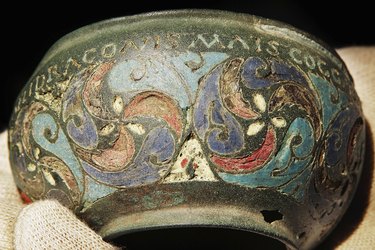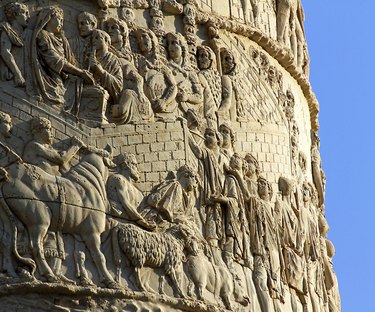
Roman art had a significant influence on Western culture, in part because of the longevity of the Roman Empire and the amount of territory that the Empire encompassed. Roman art is often criticized for being too dependent on the Greeks. While this is true in part, Roman art and artists made significant advances in different aspects of art and architecture. The rebirth of art in the Western world occurred in the Italy during the Renaissance. The artists of the Renaissance were greatly influenced by their Italian predecessors.
Influences
Video of the Day

The art of the Roman Empire was heavily influenced by the Etruscans, Rome's predecessors on the Italian mainland, and by the Hellenic influences of the Greeks. The Romans not only directly imitated and copied Greek artistic ideas, Greek artists were brought to Rome and relied upon to design and repair monumental buildings. The Greek influence was very predominant in Roman painting and sculpture.
Video of the Day
Painting

Roman painting served mostly a decorative function. It was influenced by the architecture of the time. Roman buildings tended to have a small number of doors and windows. This left large amounts of wall space. Painting techniques were developed to enhance the walls and to make the living space a more comfortable dwelling. Romans refined the technique of painting mosaics and murals and emphasized natural themes such as landscapes and narrative themes drawn from literature and mythology. The primary colors used in Roman painting were deep red, yellow, green, violet and black. The best preserved examples of Roman wall painting are Herculaneum and Pompeii.
Portrait Sculpture

Roman art also made important strides in sculpture, which can be divided into statues and relief sculptures. The Greek influence is strongly felt in Roman statues, and, in fact, many Roman statues and sculptures are copies or interpretations of Greek sculptures. However, many Roman sculptures are characterized by their realism. Greek statues tend to idealize the human form. Roman sculptors, on the other hand, presented realistic representations of their subjects with all their flaws.
Relief Sculpture

Relief sculptures were works of art carved on long pieces of stone or on the side of buildings. They were created both as decoration and as a tool to record and celebrate an important event. The size of the relief was dependent on the location and purpose for which it was intended. The relief sculpture was either a collection of figures used to represent a sequence of events, or it was intended to represent one significant event or occurrence. The wall was used as a space in which figures appear and disappear. The sculpture changed with the perspective of the viewer.